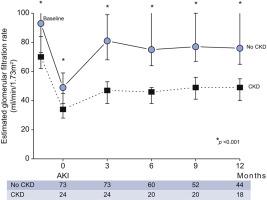当前位置:
X-MOL 学术
›
J. Hepatol.
›
论文详情
Our official English website, www.x-mol.net, welcomes your feedback! (Note: you will need to create a separate account there.)
DEVELOPMENT OF CHRONIC KIDNEY DISEASE AFTER ACUTE KIDNEY INJURY IN PATIENTS WITH CIRRHOSIS IS COMMON AND IMPAIRS CLINICAL OUTCOMES
Journal of Hepatology ( IF 25.7 ) Pub Date : 2020-06-01 , DOI: 10.1016/j.jhep.2019.12.020 Octavi Bassegoda 1 , Patricia Huelin 1 , Xavier Ariza 2 , Cristina Solé 1 , Adrià Juanola 1 , Jordi Gratacós-Ginès 1 , Marta Carol 3 , Isabel Graupera 1 , Elisa Pose 1 , Laura Napoleone 1 , Sonia Albertos 1 , Gloria de Prada 1 , Marta Cervera 3 , Javier Fernández 1 , Núria Fabrellas 3 , Esteban Poch 4 , Elsa Solà 5 , Pere Ginès 5
Journal of Hepatology ( IF 25.7 ) Pub Date : 2020-06-01 , DOI: 10.1016/j.jhep.2019.12.020 Octavi Bassegoda 1 , Patricia Huelin 1 , Xavier Ariza 2 , Cristina Solé 1 , Adrià Juanola 1 , Jordi Gratacós-Ginès 1 , Marta Carol 3 , Isabel Graupera 1 , Elisa Pose 1 , Laura Napoleone 1 , Sonia Albertos 1 , Gloria de Prada 1 , Marta Cervera 3 , Javier Fernández 1 , Núria Fabrellas 3 , Esteban Poch 4 , Elsa Solà 5 , Pere Ginès 5
Affiliation

|
BACKGROUND AND AIMS
Acute kidney injury (AKI) is common in cirrhosis and associated with poor prognosis. In patients who survive after AKI, it is not known whether the acute injury leads to chronic impairment of kidney function (chronic kidney disease, CKD). The aim of the study was to determine the frequency of CKD at 3 months of an AKI episode and its effects on patient outcomes. METHODS
Patients admitted for complications of cirrhosis during a 6.5-yr period were evaluated using the same protocol with assessment of kidney function at regular intervals during and after hospitalization. CKD was defined as estimated glomerular filtration rate (eGFR)<60 mL/min/1.73m2 at 3 months of AKI. RESULTS
409 patients (168 with AKI and 241 without AKI) were included. Survivors after 3 months were 97 and 188 from the AKI and non-AKI groups, respectively. Twenty-four of the 97 patients with AKI had developed CKD at 3 months compared to only 2 of the 188 patients without AKI (25% vs 1%, OR 31; p<0.0001). Risk factors independently associated with CKD were nosocomial AKI and severity of AKI (stage≥1B). At diagnosis of CKD, all patients had stage 3A CKD and one fourth of them progressed to stages 3B and 4 after 1-yr. Transition from AKI to CKD was associated with increased rate of 3-month hospital readmission, increased frequency of AKI, bacterial infections, ascites, and refractory ascites and a trend towards higher need for liver transplantation. Transplant-free survival was not impaired. CONCLUSIONS
CKD develops frequently in patients surviving AKI and has negative impact on relevant clinical outcomes. Transition from AKI to CKD is common and should be considered a high-risk condition in patients with cirrhosis.
中文翻译:

肝硬化患者在急性肾损伤后发展为慢性肾病是常见的,并且会影响临床结果
背景和目的 急性肾损伤 (AKI) 在肝硬化中很常见,并且与预后不良有关。在 AKI 后存活的患者中,尚不清楚急性损伤是否会导致肾功能的慢性损害(慢性肾病,CKD)。该研究的目的是确定 AKI 发作 3 个月时 CKD 的频率及其对患者预后的影响。方法 6.5 年期间因肝硬化并发症入院的患者使用相同的方案进行评估,并在住院期间和住院后定期评估肾功能。CKD 定义为 AKI 3 个月时估计的肾小球滤过率 (eGFR) <60 mL/min/1.73m2。结果 409 名患者(168 名 AKI 和 241 名非 AKI)被纳入。3 个月后,AKI 和非 AKI 组的幸存者分别为 97 和 188。97 名 AKI 患者中有 24 名在 3 个月时发展为 CKD,而 188 名没有 AKI 的患者中只有 2 名(25% 对 1%,OR 31;p<0.0001)。与 CKD 独立相关的危险因素是院内 AKI 和 AKI 的严重程度(分期≥1B)。在诊断为 CKD 时,所有患者均为 3A 期 CKD,其中四分之一在 1 年后进展至 3B 和 4 期。从 AKI 过渡到 CKD 与 3 个月再入院率增加、AKI 频率增加、细菌感染、腹水和难治性腹水以及肝移植需求增加的趋势相关。无移植存活没有受到损害。结论 CKD 在幸存 AKI 的患者中频繁发生,并对相关临床结果产生负面影响。
更新日期:2020-06-01
中文翻译:

肝硬化患者在急性肾损伤后发展为慢性肾病是常见的,并且会影响临床结果
背景和目的 急性肾损伤 (AKI) 在肝硬化中很常见,并且与预后不良有关。在 AKI 后存活的患者中,尚不清楚急性损伤是否会导致肾功能的慢性损害(慢性肾病,CKD)。该研究的目的是确定 AKI 发作 3 个月时 CKD 的频率及其对患者预后的影响。方法 6.5 年期间因肝硬化并发症入院的患者使用相同的方案进行评估,并在住院期间和住院后定期评估肾功能。CKD 定义为 AKI 3 个月时估计的肾小球滤过率 (eGFR) <60 mL/min/1.73m2。结果 409 名患者(168 名 AKI 和 241 名非 AKI)被纳入。3 个月后,AKI 和非 AKI 组的幸存者分别为 97 和 188。97 名 AKI 患者中有 24 名在 3 个月时发展为 CKD,而 188 名没有 AKI 的患者中只有 2 名(25% 对 1%,OR 31;p<0.0001)。与 CKD 独立相关的危险因素是院内 AKI 和 AKI 的严重程度(分期≥1B)。在诊断为 CKD 时,所有患者均为 3A 期 CKD,其中四分之一在 1 年后进展至 3B 和 4 期。从 AKI 过渡到 CKD 与 3 个月再入院率增加、AKI 频率增加、细菌感染、腹水和难治性腹水以及肝移植需求增加的趋势相关。无移植存活没有受到损害。结论 CKD 在幸存 AKI 的患者中频繁发生,并对相关临床结果产生负面影响。


























 京公网安备 11010802027423号
京公网安备 11010802027423号